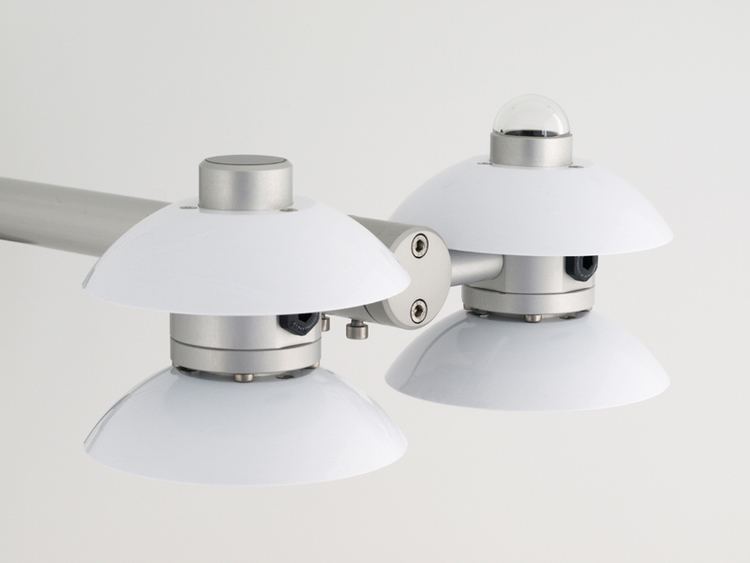 | ||
A net radiometer is a type of actinometer used to measure net radiation (NR) at the Earth's surface for meteorological applications. The name net radiometer reflects the fact that it measures the difference between downward/incoming and upward/outgoing radiation from Earth. It is most commonly used in the field of ecophysiology.
Contents
Working Principle
The net radiometer is based on a thermopile sensor whose warm joints are in thermal contact with the receiver while the upper cool joints are in thermal contact with the lower receiver. The temperature difference between the two receivers is proportional to the net irradiation. The temperature difference between hot and cold junction is converted into a voltage by Seebeck effect. The two receivers are made from a portion of spherical coated Teflon®. The particular form of the two receivers provides a response in accordance with the cosine. The Teflon® coating, as well as allowing outdoor installation for long periods without risk of damage, can have a constant spectral response from ultraviolet (200 nm) up to far infrared (100 μm).
Installing and mounting the net radiometer for total irradiance measurements
To allow cleaning the two receiving surfaces regularly, LP NET 07 should be mounted in easily reachable places. The surfaces can be washed with plain water or pure ETHIL alcohol. Mount the instrument so that no shadow will be cast on it at any time of day and of the seasons, from obstructions such as buildings, trees, or any other obstacle. In the NORTHERN hemisphere, the net radiometer is normally oriented towards SOUTH, while it should be oriented NORTHWARD, in the SOUTHERN hemisphere. The instrument should be mounted at a height of at least 1.5 m above the ground. Please note that the flow on the lower receiver is representative of a circular area with a radius of 10 times the height. When installing the net-radiometer avoid, wherever possible, to touch the surfaces of the receiving net-radiometer.
Terminology
Although there are many types of net radiometers, the 4-component design at present is most popular for scientific applications.
A 4-component net radiometer serves to measure 4 separate components of surface radiation balance: SWin direct incoming short wave radiation, SWout or reflected short wave radiation, LWin diffused long-wave radiation from the sky and LWout long-wave radiation emitted by the ground surface. In net radiometers, shortwave radiation is measured with pyranometers which measure incoming shortwave radiation and reflected shortwave radiation (albedo), and longwave radiation is measured with pyrgeometers. The working range of pyranometers is 300 to 2800 nm wavelength and that of pyrgeometers is 4500 to 100000 nm wavelength.
The surface of the upper receiver measures the direct solar radiation plus the diffuse one and the radiation at longer wavelengths emitted from the sky (clouds), while the lower receiving area measures the solar radiation reflected from the ground (albedo) and the radiation length wavelengths emitted from the earth. The instrument is designed and constructed to be used outdoors in any weather conditions. Besides its use in meteorology to measure energy balance, it can be used indoors for the measurement of radiant temperature (ISO 7726).
Calculations
NOTE: the following formulas have T in kelvins. Add 273.16 to convert to temperature in degrees Celsius.
U is the voltage output of a sensor, E is radiation at the sensor surface, up = upfacing instrument, down = downfacing instrument, SW = shortwave or solar radiation, LW = longwave or far infrared (FIR) radiation, in = incoming, out = outgoing, T = temperature, NR = net radiation.
SWin = Upyrano,up / Epyrano,up
SWout = Upyrano,down / Epyrano,down
LWin = (Upyrgeo,up / Epyrgeo,up) + 5.67×10−8 Tpyrgeo4
LWout = (Upyrgeo,down / Epyrgeo,down) + 5.67×10−8 Tpyrgeo4
NOTE: in the LWnet the instrument temperature is cancelled:
LWnet = (Upyrgeo,up / Epyrgeo,up) - (Upyrgeo,down / Epyrgeo,down)
SWnet = (Upyrano,up / Epyrano,up) - (Upyrano,down / Epyrano,down)
NR = SWnet + LWnet
Special parameters that can be deduced:
SWalbedo = SWin / SWout
Tsurface = (LWout / 5.67×10−8)1/4
Tsky = (LWin / 5.67×10−8)1/4
The SWalbedo and the Tsurface must be estimated from other sources, and the NR can be calculated using these plus the SWin and LWin measurements.
SWalbedo typically is assumed to be a constant, typically taken from local satellite observations; Tsurface can often be calculated from air temperature or ground temperature measurements.
Usage
Net radiometers are frequently used in meteorology, climatology, solar energy studies and building physics. They can be seen in many meteorological stations—typically installed horizontally.
Standardisation
Net-radiometers are not standardised.
